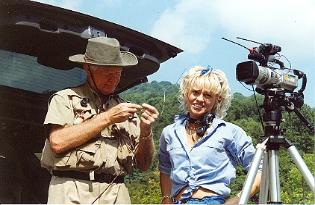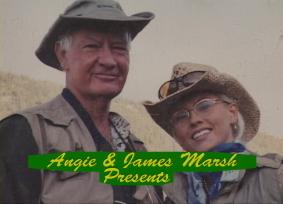The “Perfect Fly Store” is an online and catalog mail order company established to sell
“Perfect Fly” fly fishing products worldwide. It was established primarily to sell Perfect Flies
and Perfect Fly fly fishing gear that we manufacturer directly to the customer. The
company was established in August of 2008.
“Perfect Fly” is the name of the fly, fly fishing gear and fly fishing equipment manufacturing
part of the company.
Since we do not have the typical, walk-in retail fly shop business and its associated
overhead expense, it’s possible for us to sell the highest quality flies and fly fishing gear
and equipment available directly to the customer at the lowest possible prices.
Shipping and handling is FREE anywhere in the Continental United States. There’s no
minimum purchase required for free shipping.
In summary, we are a manufacturer with direct sells to customers, not a brick and mortar fly
shop.
Meet Angie and James Marsh
James Marsh
Teaching others to fish has been a rewarding, lifetime devotion for James Marsh. For almost five decades he has made his sole profession producing fishing and other instructional outdoor videos. Although he has cast, on-camera, in fresh and salt waters around the world, catching almost every species of sport fish that swims, his most rewarding experiences comes from fly-fishing at home in the United States of America.
Angie Marsh:
As you can see by watching their video series, during the twelve year course of production, James’ wife Angie, starting from scratch, became an accomplished angler, proving that it doesn’t take a life-time to learn how to fly fish skillfully and successfully. Assisting in the production of the series greatly shortened the learning curve for her and their instructional DVD’s can do the same for you.


James’ Background:
Like many avid anglers, James began fishing at a very early age. Thanks to his father and grandfathers, at a very young age James was able to fish several North Alabama ponds, Guntersville Lake, and the Gulf of Mexico on a regular basis. His fly-fishing experience began at age five or six catching bass and bluegills from local farm ponds and lakes.
In his early twenties, James became interested in fishing for the large spawning bass in Central Florida Lakes and the St. Johns River. For eight years he spend at least a month a year doing such in addition to fishing other lakes and the Gulf of Mexico as often as he could. In 1976, he started fishing the BASS pro circuit, along with a lot of other regional and local bass tournaments and did so until 1980. These tournaments took him from his home in Birmingham and later Mobile, Alabama to such places as Arizona, New York, and Florida competing against many of the pros that helped found the professional bass circuit.
In 1980, James found that he was spending far more time saltwater fishing than bass fishing and stopped competing in the bass tournament circuit to start the first ever syndicated TV series primarily on saltwater fishing called the “Gulf Coast Angler”. After a successful first year and several added stations, he changed the program name to “Fishing with James Marsh” and expanded the fishing locations to include the Atlantic Ocean and Caribbean. At a that time, when there were no cable TV stations, only three networks and a few independent stations, his syndicated show was able to obtain very high TV ratings at twenty-six major markets that represented about half of the nation. For example, in the Tampa, Florida market, running at prime time, 7:00 P.M. Sunday nights, his ratings exceeded that of the three other competing programs with the exception of Sixty Minutes. The ratings of several of his programs in markets airing on weekend schedules during the winter months exceeded that of NBA (basketball) programs.
In 1985, he founded a new business called “Fins N Tales”. Fins N Tales produced Bass Video Magazine and Saltwater Video Magazine that provided quarterly videos to its subscribers. His new venture and its concept, two fishing video magazines, was sold to his partner, Ted Thomas, in 1987. At that time, about the same time half of the nation’s homes had VCRs, James began producing instructional videos on fishing. At the end of the first year, he sold one-half interest in his programs to Michael Bennett and licensed Bennett Marine Video of Marina Del Ray, California (now the World’s largest distributor of boating, fishing and other marine related videos) as exclusive distributor. This same joint venture now has forty-six instructional video and DVD programs on fishing, over twenty-six boating programs and numerous other outdoor and fishing related programs such as instructional GPS, sonar (fishfinder), radar and navigation videos. Many of these programs are available from companies such as Cabelas, Bass Pro Shops, REI and West Marine. He currently continues to produce programs for Bennett Marine Video.
In 1992, James begin fishing the SKA professional “Kingfish” circuit as well as the SAA or “Saltwater Anglers Association” circuit. He competed in these tournament circuits from North Carolina to Texas until 1998. During this time he was sponsored by Ranger Boat Company and was on their promotional staff for their new line of saltwater boats. He tested and help improve the 25 foot model doing such things as crossing the Gulf of Mexico with twin outboards for power.
During the 1980s and 1990s, James wrote numerous magazine articles for several publications including Marlin Magazine, Sportfishing Magazine and others. He traveled extensively fishing in several countries. His saltwater fly-fishing experience during those years was primarily limited to sailfish and other offshore species such as dolphin. Most of the other offshore fishing for marlin, tuna, wahoo and other offshore species was done using conventional tackle. He has taken three sailfish on the fly in one day off the Mexican coast. Trips to Alaska provided huge rainbow trout, grayling and several different species of salmon on the fly.
In 1998, James and his wife Angie, started fly-fishing for trout extensively. He purchased every video, book, magazine and ask every question he could get any fly angler to answer. Having produced instructional videos on fishing for many years, James was amazed at the low level of both the production quality and content quality of the videos that were available at the time. Most of them were “watch someone catch a fish” or TV formatted programs rather than instructional and educational programs. The only real attempts at instructional videos that existed were on casting and fly tying. The casting videos poorly attempted to show viewers how to make long cast of up to one-hundred feet or cast that completely straightened the line. None focused on how to make accurate cast of distances appropriate for trout. None demonstrated how to make (messed up cast) curve, pile, and other such cast that are actually necessary to get drag free drifts when fly fishing for trout. The program host’s main objective appeared to be showing the viewers how far they could cast.
The fly tying videos were like the fly fishing programs, mostly, “watch someone tie a fly” programs. In other words, in James’ opinion, most all of the videos available on fly fishing for trout didn’t include what should be the most important subjects such as the details on what the trout eat, fly presentation, etc. It was also obvious that most of the programs were produced by people that spent more time selling gear in a fly shop, or by guides promoting their services and spent most of their time attempting to teach beginners the basics. The tying videos were usually hosted by professional fly tiers that regularly tied hundreds of rough imitations necessary to compete with the low priced Keyna and Asian flies. Most all the fly-fishing videos were and still are for that matter, hosted by people more interested in selling something else, such as a service or product, than they are teaching the viewer how to catch fish on the fly. Most of the anglers James meet caught trout more as a result of luck than actually knowing what they were doing or anything about what they were trying to imitate.
In 1998, James decided to produce his own series of programs that would teach anyone what they needed to know from start to finish. He would have probably named it “The School of Fly Fishing” if similar names had not already been used so often by others. In effect, that’s what “Fly Fishing DVD” set out to do. He wanted to teach anglers, including those that were just beginning and those that had progressed to a level somewhere in between a beginner and an expert, what they needed to know in order for them to be able to catch trout as a result of their actually knowing what they were doing. Most anglers have to rely on pure luck. That’s why he used the marketing phrase, “you can get your PhD in fly fishing right here”.
James doesn’t accept offers from sponsors because he doesn’t want any obligations to anyone. He doesn’t spend any of the DVD program time that customers are paying for promoting any particular product or service.
Since 1998, Angie and James have fly-fished in forty-four states (James 49). They fly-fish, on camera, year round throughout the nation on a regular basis. As of November 12, 2006, the date this was written, they had already spent over two-hundred days fly-fishing for trout during the first ten months of the year of 2006. They have caught and made videos on just about every item of trout food that exist including most all the important species of mayflies, stoneflies, and caddisflies.
The production of these programs has taken a lot of time, money and considerable effort. Unlike most fly-fishing videos, their videos were not shot in a day or two at one or two locations. Each of them were digitally recorded from coast to coast on dozens of different streams. Hundreds of hours have been spent capturing, studying and shooting closeups of insects and other trout food. Some of these programs are yet to be released. Several that are almost but not fully completed will be released in the near future. Production of fly-fishing videos is their profession, not a part time effort to promote another related job, product or business. Teaching others to fish has been a lifetime endeavor for James Marsh.